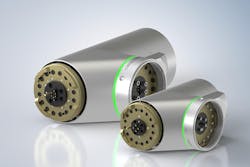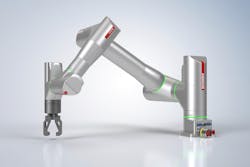Numerous new robotic technologies have debuted over the past two decades, but the new ATRO robot system from Beckhoff may be one of the first modular, DIY (do-it-yourself) robot technologies for the industrial market. The ATRO (Automation Technology for Robotics) system is a modular industrial robot system that allows end users, integrators, and machine builders to create an optimal robot configuration for their application.
Beckhoff notes that all ATRO modules feature an internal media feed for data, power, and fluids (vacuum, air, and water). This allows ATRO to use a variety of tools, such as mechanical, pneumatic, or electric grippers. Because these media feeds are internal, it allows for endless rotation of ATRO axes and end effector tools, as there are no external cables to hinder the robot’s range of motion (see video below).
Furthermore, the ATRO system is built on an open control architecture, enabling it to be connected to “all conceivable interfaces in cell/plant communication, such as Profinet, EtherNet/IP, OPC UA, or to the cloud,” Beckhoff says. Also, the ATRO system allows for all functions such as robotics, vision, safety, and machine learning to be integrated on a single control platform.
If you’re wondering whether the ATRO is an industrial robot or cobot, Beckhoff says the ATRO is an industrial robot that can accomplish TwinSafe Motion commands such as: Safe Limited Speed (SLS), where the robot’s speed is safely limited to a specified speed window; Safe Operating Stop (SOS) where the robot’s drive is safely monitored at a particular position; Safe Stop 2 (SS2) where the robot’s drive is ramped down to a stop and stays safely controlled in stop mode; and Safe Torque Off (STO) where all torque-generating energy to the robot is cut off immediately.
Before going further into ATRO’s details, it should be noted that this is an early preview of ATRO. The technology is not yet available for purchase.
ATRO capabilities and modules
The ATRO system can handle payload capacities ranging from 3 kg to 10 kg with a reach from 0.6 meters to 1.3 meters. Information on ATRO robot speeds has not yet been released, but Matt Prellwitz, drive technology product manager at Beckhoff Automation, says Beckhoff plans to release ATRO kits for 6-axis serial robot creation later this year. At that time, information on robot speeds will be released.
ATRO motor modules will be available in three designs: L- and T-motor modules for use as 90-degree angle joints and straight I-motor modules created to reduce flange size.
Length of the ATRO link modules vary and are available in I-shape, L-shape, T-shape, and Y-shape.
The base of the ATRO robot can be floor-, wall- or ceiling-mounted. Connection to the internal media feed can be done from the side or the bottom of the base unit.
Regardless of the type of robot structure created, the resulting assembly is scanned by the control system, enabling the built-in TwinCAT robotics functions to automatically create the corresponding control application, including a digital twin.
See the video below about ATRO’s different module types.
DIY assembly
Beyond its customizable design configuration, two other interesting aspects of ATRO are its assembly and the visual reinforcements it provides to the assembler and user that each module is correctly connected and ready for operation.
Assembly of an ATRO robot is accomplished using a method similar to a slip ring to connect each module and an adjustable tool to secure the joint in place.
As each module is connected, a light lining the joint connection illuminates. When the light is yellow, it has verified that EtherCAT communications between modules is effective; a green light indicates the module is ready for operation; and a blue light indicates the unit is ready for manual teach mode.
Regarding specific applications for which ATRO is best suited, Prellwitz says “ATRO can be added to any application, and the flexible design helps users easily fit the system into new and existing machine designs. Common applications include assembly, material handling, lab automation, and packaging.”
The video below highlights ATRO’s DIY assembly.
EtherCAT’s integration role
The open architecture of the ATRO system allows for interfacing with other, existing robot systems in a plant via EtherCAT. Prellwitz explains that KUKA offers EtherCAT integration across its robot portfolio. “KUKA also offers robots with fail safe over EtherCAT (FSoE), so users can pass safety data from the robot system to the TwinCAT automation system,” he says. “Stäubli also uses EtherCAT through its robot portfolio and allows users to connect EtherCAT I/O modules such as robot- and machine-mountable I/O boxes or IP20-rated I/O for enclosures. And Denso uses EtherCAT communication in new robots to allow integration of EtherCAT servo drives and EtherCAT I/O. For example, Denso’s new RC9 control platform uses EtherCAT networking and EJ series pluggable I/O terminals from Beckhoff, with a Beckhoff industrial PC as the controller hardware.”
EtherCAT also allows for integration of I/Os, feed axes, and/or the ATRO interface, so that standard grippers from different manufacturers can be connected via adapter plates.
Using TwinCAT as the programing software for ATRO enables users to develop XPlanar and XTS projects in the same environment. Prellwitz says, “This allows you to easily integrate these advanced transport technologies, as well as basic components like pallets with storage bins or simple conveyors.”
Sponsored Recommendations
Leaders relevant to this article:





